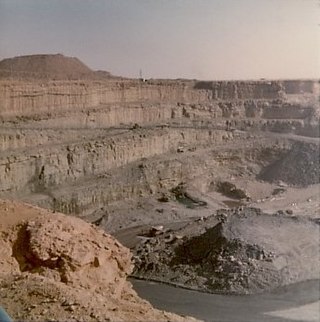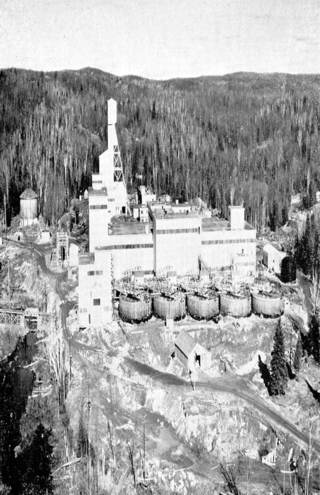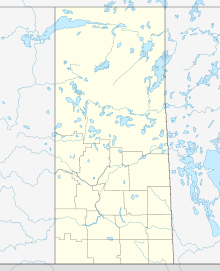
Carswell is an impact structure within the Athabasca Basin of the Canadian Shield in northern Saskatchewan, Canada. It is 39 kilometres (24 mi) in diameter and the age is estimated to be 115 ± 10 million years. The crater is exposed at the surface.

Areva S.A. is a French multinational group specializing in nuclear power headquartered in Courbevoie, France. Before its 2016 corporate restructuring, Areva was majority-owned by the French state through the French Alternative Energies and Atomic Energy Commission (54.37%), Banque publique d'investissement (3.32%), and Agence des participations de l'État (28.83%). Électricité de France, of which the French government has a majority ownership stake, owned 2.24%; Kuwait Investment Authority owned 4.82% as the second largest shareholder after the French state.

Arlit is an industrial town and capital of the Arlit Department of the Agadez Region of northern-central Niger, built between the Sahara Desert and the eastern edge of the Aïr Mountains. It is 200 kilometers south by road from the border with Algeria. As of 2011, the commune had a total population of 112,432 people.
Cluff Lake Airport(IATA: XCL, TC LID: CJS3) is a decommissioned airstrip located near Cluff Lake mine in north-western Saskatchewan, Canada at the northern terminus of Highway 955.
The McArthur River Uranium Mine, in northern Saskatchewan, Canada, is the world's largest high-grade uranium deposit.
The Key Lake mine is a former uranium mine in Saskatchewan, Canada. It is 570 kilometres (350 mi) north of Saskatoon by air on the southern rim of the uranium-rich Athabasca Basin. Key Lake was initially developed to open-pit mine two nearby uranium ore deposits: the Gaertner deposit and the Deilmann deposit. Mining of this ore ceased in the late 1990s; the Key Lake mill now processes uranium ore from the McArthur River mine and from existing stockpiles on site. High-grade ore from McArthur river is blended with lower grade local rock before being passed through the mill. The mill has a permitted annual production capacity of 25 million pounds of U3O8. In addition, ammonium sulfate fertilizer is produced as a byproduct from used reagents. The pits of the mined out local deposits are being used as mill tailings management facilities.
Rabbit Lake is the second largest uranium milling facility in the western world, and is the longest operating uranium production facility in Saskatchewan. The facility is located approximately 800 km north of Saskatoon, Saskatchewan, on the northeast edge of the uranium rich Athabasca Basin. The closest community is Wollaston Lake, about 40 kilometers by lake or air. Rabbit Lake was the first Canadian mine to offer a seven-days-in/seven-days-out commuter system of staffing. Access is provided by Highway 905. Production at Rabbit Lake was suspended in April 2016.
The McClean Lake mine is a uranium mine and milling operation located west of Wollaston Lake, about 700 kilometres north of Saskatoon, in the Athabasca Basin region of Saskatchewan, Canada. The McClean ore body was discovered in 1979, followed by the discovery of the JEB ore body in 1982. From 1985 to 1990, a cluster of deposits named Sue A, Sue B and Sue C were discovered.

Madawaska Mine (previously known as Faraday Mine) is a decommissioned underground uranium mine in Faraday, near the town of Bancroft, Ontario, which produced 9 million pounds (4,082 tonnes) of U3O8 concentrate, at an average ore grade of 0.1074%, during its two periods of production.

The Cigar Lake Mine is a large high-grade underground uranium mine, located in the uranium-rich Athabasca Basin of northern Saskatchewan, Canada, at the south-west corner of Waterbury Lake. The deposit, discovered in 1981, is second in size of high-grade deposits only to the nearby McArthur River mine. Other deposits, such as Olympic Dam in Australia, contain more uranium but at lower grades.

Canada is the world's second-largest producer of uranium, behind Kazakhstan. In 2009, 20% of the world's primary uranium production came from mines in Canada. 14.5% of the world production came from one mine, McArthur River. Currently, the only producing area in Canada is northern Saskatchewan, although other areas have had active mines in the past.

Nuclear industry in Canada is an active business and research sector, producing about 15% of its electricity in nuclear power plants of domestic design. Canada is the world's largest exporter of uranium, and has the world's second largest proven reserves. Canada also exports nuclear technology within the terms of the Nuclear Non-proliferation Treaty, to which it is a signatory, and is the world's largest producer of radioactive medical isotopes.

The Gunnar Mine was a uranium mine in northern Saskatchewan, Canada, located around 25 kilometres (16 mi) southwest of the community of Uranium City, and approximately 600 km north of Saskatoon. This mine is situated on the Crackingstone Peninsula on the north shore of Lake Athabasca in the Beaverlodge Uranium District. Over its lifetime, this mine produced 5 million tonnes of uranium ore and around 4.4 million tonnes of mining tailings.
The Beaverlodge Mine sometimes referred to as the Eldorado Mine or the Beaverlodge Operation was a uranium mine in the community of Eldorado, northern Saskatchewan, Canada. Eldorado was a small community 7 kilometres (4.3 mi) east of the community of Uranium City, Saskatchewan in the Beaverlodge Uranium District built by Eldorado Mining and Refining Limited to house the workforce and families of the mine.
Orano Canada is a uranium mining, milling, and exploration company headquartered in Saskatoon, Saskatchewan, Canada. Orano is a subsidiary of the Orano Group, an international nuclear energy company headquartered in Paris, France with 16,000 employees worldwide.
The Agnew Lake Mine was a uranium mine located in the township of Hyman approximately 10 kilometres (6.2 mi) northeast of Agnew Lake, Ontario and 75 kilometres (47 mi) east of Elliot Lake, Ontario.

Orano SA is a multinational nuclear fuel cycle company headquartered in Châtillon, Hauts-de-Seine, France. The company is engaged in uranium mining, conversion-enrichment, spent fuel recycling, nuclear logistics, dismantling, and nuclear cycle engineering activities. It was created in 2017 as a result of restructuring and recapitalizing of the nuclear conglomerate Areva. Orano is majority owned by the French state. As of September 2021, Orano is the second largest uranium producer in the world with 9% share in global uranium production.

Bicroft Mine is a decommissioned underground uranium mine, located in Cardiff, near Bancroft, Ontario, Canada.

Greyhawk Mine is a decommissioned underground uranium mine located in Faraday Township near Bancroft, Ontario. It operated from 1954 to 1959 and from 1976 to 1982. The mine produced 80,247 tons of uranium ore, of which 0.069% was U3O8 worth $834,899.















